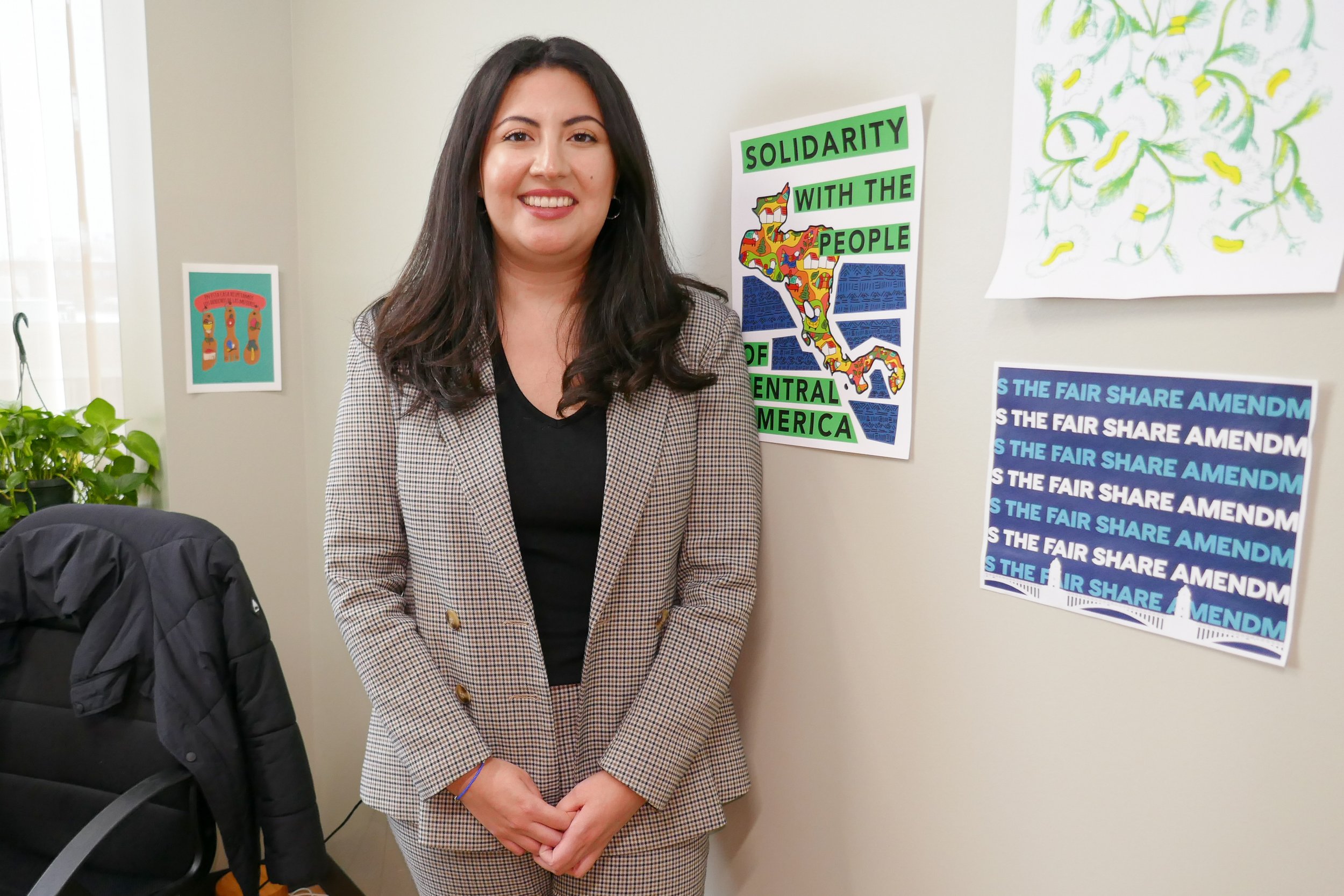Borrower’s Remorse
Total federal student loan debt stood at $1.7 trillion as of February 2023. Photo by Laura Carmen Arena for palabra
As the legal battle continues over a federal student loan forgiveness plan, many Latino families face their own tough circumstances when it comes to ballooning college debt
Haga clic aquí para leer este ensayo en español.
Iliana Panameño wanted to get a master’s degree in social work, just like her mother. To afford enrollment at the Boston University School of Social Work, she moved back to her parents’ home in Malden, Massachusetts. Panameño took out graduate loans under her own name to avoid burdening her parents financially and risking delaying their retirement — a move that came at a cost.
Today, Panameño’s mix of federal and private loan payments hover around $1,500 a month. This year, her monthly payment could increase with the Biden administration’s three-year pause on federal student loan debt collection set to end either on Sept. 1 or 60 days after court challenges to the debt relief program are resolved. (These challenges have reached the Supreme Court.)
“The pause on student loan (payments) has been a huge relief,” Panameño said. “I feel I’m in a space to save more.” Yet she wonders about her financial future once the federal pause is lifted and if things like retirement will be possible.
Iliana Panameño, communications specialist at GreenRoots, in her office at the environmental justice organization's headquarters in Chelsea, Mass. Photo by Laura Carmen Arena for palabra
She knows things could be worse. In Boston’s red-hot housing market, she lives rent-free with her parents. She helps them with utility payments and sending remittances to relatives in El Salvador. She also gets to live her dream of pursuing organizing work as a communications manager for GreenRoots, an environmental justice non-profit based in the working-class, heavily Latino city of Chelsea.
Last year, Panameño and her sister felt financially secure enough to try and buy a condo together. One purchase fell through. Then, mortgage rates rose, freezing their plans. “I have a good job, a good-paying job,” Panameño said. But she couldn’t imagine buying a home on her own given her loan burdens. She also hears her friends’ concerns about loans blocking plans for their lives. “They’re not confident they can afford to have a family because of student loans,” she said. “Will we be working forever to pay them off?”
Iliana Panameño and family. Photo courtesy of Iliana Panameño
Nationwide, 43.5 million student loan borrowers owed a record $1.75 trillion in collective federal debt as of Feb. 2023. Latino borrowers feel the burden heavily: Latinos take out loans at a higher frequency, and default on their loans more than their white counterparts, and also represent the fastest-growing population of student enrollees.
Overall, 18 to 20% of outstanding borrowers in the U.S. are Latino, according to Laura Beamer, a lead researcher on higher education finance at the Jain Family Institute, a nonpartisan research group. “We can only assume more Latinos are going to be borrowing in the future than they are now,” Beamer said.
Beamer’s colleague, Eduard Nilaj, a data science research associate, said that when the federal loan pause ends, harsh consequences may follow. “It will be more difficult to stay in a home mortgage,” Nilaj said, adding that some borrowers will find it tough to decide “which debt they are going to pay off first.”
‘It was a normal thing to go to a private institution…I just went with the flow.’
“A lack of resources — not only financial, but a lack of knowledge — really is the core of the problem,” said Jaclyn Piñero, who leads uAspire, a Boston-based national nonprofit that counsels marginalized communities about college. Of the population served by uAspire, 41% is Latino, totalling about 4,000 borrowers per year.
“Particularly for first-generation students,” Piñero said, “it’s hard to find someone else in the community who has gone down that path before, who can help lessen that knowledge gap, find choices and opportunities for continuing education past high school.”
Panameño does have such a role model: her mother, who arrived in the U.S. from El Salvador on a work visa and earned a master’s in social work at Boston College. Yet having a parent with a graduate degree did not spare Panameño from student loans. For her undergraduate studies, Panameño headed to Union College, a Seventh-day Adventist private institution in Lincoln, Nebraska. She said that her family was steered toward a PLUS loan with a high interest rate. The federal loan, run by the Department of Education, is offered to parents of undergraduate and graduate students.
Students walk along the Boston University campus on Commonwealth Avenue on a chilly February afternoon. Photo by Laura Carmen Arena for palabra
“Even though I have a parent who was able to explore going to college and completed college,” Panameño said, “I thought there was still not a lot of information about how the process works.”
For those who can avoid high loan balances, there are other challenges. Ruth Alcantara, a colleague of Panameño’s at GreenRoots, studied at the University of California, Santa Barbara (UCSB), which offers a tuition discount for state residents. That allowed Alcantara to stay close to their Guatemalan immigrant family in Los Angeles. Guatemalan identity is important to Alcantara, who keeps a sign in memory of the genocide of indigenous Maya communities in Guatemala on their desk at GreenRoots.
To further close the funding gap, Alcantara worked multiple jobs at UCSB over their five school years from 2017 to 2022, including overnight shifts at the school library and remote work during the pandemic. At one point, their work schedule was nearly equivalent to a full-time job.
“If there was one thing my parents always told me, it was don’t get too much in debt for going to school,” Alcantara said. “I had to sort of sacrifice by working a lot — my physical well-being, my mental well-being a little bit. It was a constant grind — work, school, sleep, then work, school, sleep. Sometimes, I wouldn’t even sleep.”
Ruth Alcantara prepares for a virtual meeting at GreenRoots, an environmental justice non-profit based in Chelsea, Mass. Photo by Laura Carmen Arena for palabra
Latinos who do borrow money for higher education have mixed feelings about the loans. Anna Rosario, the daughter of Dominican parents with a strong religious faith, was the first of nine siblings to go to college. She went to an all-girls Catholic high school in the Bronx where, she said, there was little encouragement to attend the more affordable City University of New York (CUNY) system. “It probably would have had the most affordable tuition,” Rosario said. “I didn’t do that.”
Instead, Rosario applied to Manhattan College, a private, Catholic liberal arts university in the Bronx. “It was a normal thing to go to a private institution,” she said. “I just went with the flow.”
Tuition at Manhattan College is $46,100 for the current academic year and $23,050 per semester. The CUNY system costs $6,930 per year for New York State residents in the full-time, four-year college program. At first, Rosario tried paying her tuition on a semester-by-semester basis, but that led to late class registrations. Then, one of Rosario’s sisters also began college, further straining the family’s finances. “It became very apparent that it was a struggle for my household,” Rosario said.
‘The more general financial literacy can be taught at places like public high schools and community centers, the better off Latino communities will be when they come to this point in their lives.’
Her family took out additional private loans to allow Rosario to register for classes on time. “I just wanted to go to school, not stress over the money,” Rosario said.
Christopher Rivas knows this sentiment firsthand. Growing up, he dreamed of becoming an actor. To afford the California Institute of the Arts, his financially-strapped parents co-signed for his student loans for what he calls “massive amounts.” Looking back, Rivas said, “These were people who did not understand what they were reading.”
Spanish-speaking immigrant families may also have trouble understanding loan documents filled with unfamiliar financial terms. Experts therefore recommend more financial education at the high school level, tailored toward immigrant communities. “There needs to be financial literacy programs available for Latino students and families,” said Erica Romero, vice president of education policy and advocacy at Latinos for Education.
Some states are taking action on this front. Last year, the list of states that mandate financial literacy in the high school curriculum rose to 14, with Michigan the most recent to do so. “The more general financial literacy can be taught at places like public high schools and community centers, the better off Latino communities will be when they come to this point in their lives,” said uAspire’s Piñero.
Six months after graduating from the California Institute of the Arts, Rivas’ loan payments were due and totaled more than twice his rent in Los Angeles. Exhausting his options, he found an unconventional solution — he entered a Ph.D. program at the European Graduate School in Saas-Fee, Switzerland called “Expressive Arts: Therapy, Coaching, Consulting & Education, Conflict Transformation & Peacebuilding.” Typically, graduate students can qualify for federal loan deferments. Rivas postponed his undergraduate loan payments by taking out graduate loans from the U.S. government.
Today, Rivas is a working actor, co-starring on the TV series Call Me Kat. He’s still paying off his loans. The monthly amount is more than his rent, but he appreciates having the means to do so.
Rosario, who graduated from Manhattan College in 2020, now works on the other side of the table as an admissions official at the college. She advises youth at her local parish, many of whom come from immigrant families. She alerts students against taking out the full amount of loans offered if they only need a portion of it and have other means of covering the balance. Meanwhile, she knows that many students must translate loan documents for their parents. She wishes that colleges and universities would hold financial aid sessions in languages other than English and provide translated documents.
“The skill set I gained in working in admissions helps not only me, but my community,” Rosario said. “It’s very much a process, especially when it comes to first-generation students and students of color in general. I try to assist families whenever I can.”
_
Rich Tenorio is a writer and editor whose work has appeared in a variety of media outlets. He is a graduate of Harvard College and the Columbia University Graduate School of Journalism.Tenorio is also a cartoonist.
Laura Carmen Arena is an Argentinian American writer and photographer. Her photography has appeared in local and international outlets. A porteña and New York transplant to Cambridge, Mass., she specializes in outdoor and documentary photography and writes fiction and nonfiction on culture and the environment. She studied literature at New York University and visual arts and creative writing at Harvard University.









